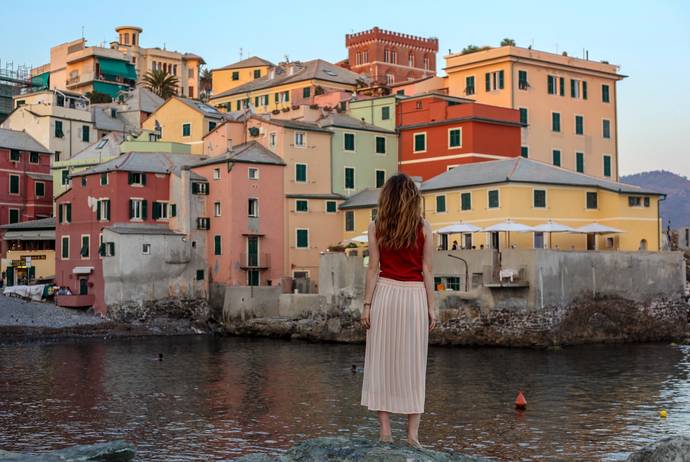In an evening of politically-correct acceptance speeches, besides Spike Lee’s, historic victories for African Americans, although they unfortunately missed out on some of the biggest prizes (like Lee’s “BlacKkKlansman”), and questionable fashion choices on the red carpet, we have to thank Lady Gaga and Bradley Cooper for warming our hearts with their intimate performance at the 91st Academy Awards ceremony. Also, regardless of the controversy, “Green Book,” the story of a black classical musician and his Italian American driver in the 1960s (co-written by Nick Vallelonga), was the only surprise in an otherwise very predictable evening.
GAGA AND COOPER'S HOT PERFORMANCE
Before “Green Book” surprised the audience with its unexpected and controversial Best Picture victory, Lady Gaga and Bradley Cooper had us fantasizing about a possibly real romance between this amazing pair of genuine Italian Americans from the East Coast.
The chemistry between Stefani Joanne Angelina Germanotta, aka Lady Gaga, and Cooper, whose maternal grandparents were born and raised in Italy and whose mother, Gloria Campano, is the daughter of a policeman from Naples,could conceivably come from their common roots.
The connection between them was palpable during their earlier press conference at the Venice Film Festival, as Vanity Fair wrote. At that time, Cooper admitted that, even before he knew that Lady Gaga was Italian American, they were already sharing homemade food that she had cooked after only 10 minutes together. The actor recalled: “It was actually a huge bond that we both came from East Coast Italian-American families. So we had a real synchronicity on that level from our upbringing.” Cooper also said that he immediately “fell in love with her face and eyes.”
Well, that alchemy was even more obvious last night when the duo sang “Shallow,” awarded as Best Original Song. It is the main tune in “A Star Is Born,” a movie that was produced, written, and directed by Cooper who also stars in it. Some people speculate, or hope, that the romance between the two artists might be real. Mel B, the ex Spice Girls singer, even said that their performance made her feel uncomfortable the whole time on behalf
of Cooper’s girlfriend, Irina Shayk.
But Shayk, mother to Cooper’s 1½-year-old daughter, sat all night between the two stars reminding us that, despite rumors, the two actors chemistry stops at their Italian American origins and fictional characters.
GREEN BOOK’S CONTROVERSIAL VICTORY
“Green Book” won three Oscars in total, including Best Picture, which had been expected to go to Netflix's “Roma.” This surprise victory sparked even more controversy for a movie that, even before its Academy Awards nominations, had been subject to broad criticism, from being backward to being a movie made by white people for white people. But, at least, it gave media outlets something to write about last night gala.
“Green Book” was also criticized for presenting the usual stereotypes about Italian Americans. Yet, it was co-written by Nick Vallelonga, the main character’s real son, who, together with Brian Hayes Currie and Peter Farrelly, won best original screenplay for this movie. We will leave the final judgment to our readers.
We think that although “Green Book” might indeed be a predictable and cliched, the superb acting both of Mahershala Ali, who won his second Oscar as Best Supporting Actor, and Viggo Mortensen is for sure worth the price of the theater ticket.
Overall, we were impressed by Mortensen’s interpretation of Tony Vallelonga. Despite not having a single drop of Italian blood, the actor bravely took on the role of this Italian American bouncer from the Bronx.
Mortensen confessed that at first he refused that role because there are already great, real Italian American actors out there, and he was reluctant to play a stereotyped character.
Then, he met the Vallelonga family, heard recordings with Tony’s voice and little by little felt comfortable with that role. Indeed, we think that Mortensen gave a super interpretation and it is a shame he missed out on winning the Best Actor Oscar.
ITALIAN SPIDERMAN
It might not have been in the spotlight last night, but “Spider-Man: Into the Spider-Verse” became one of the few non-Disney movies to claim the Best Animated Feature title in the history of the Academy Awards. Behind this success there are an Italian American director, Bob Persichetti, and an Italian comic artist, Sara Pichelli.
Bob Persichetti co-directed a cartoon that was able to tell and show the story of a very popular superhero in a totally different and original way. We do not have a bio of Persichetti, so we can only guess his Italian origins based on his his last name.
Instead, we know for sure that Sara Pichelli is Italian. She was born in Porto Sant’Elpidio, Le Marche region, in 1983, and illustrated the cartoon's main character, Miles Morales.
It must not have been an easy task for her. Pichelli was discovered by Marvel in an international talent search, and she had to create an Afro-Latino teenager from Brooklyn, a character that couldn’t be more different from her.
Yet, just as Danish American Viggo Mortensen could successfully embody the role of Tony Vallelonga, Pichelli, a young Italian artist, was able to give life to a unique, new Spiderman who became an inspiring model for many teenagers who share the superhero's ethnic background.







































